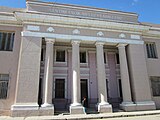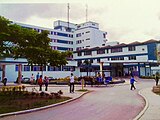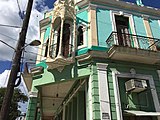Colón, Cuba
Colón | |
|---|---|
 Christopher Columbus Statue of Colón | |
 Colón municipality (red) within Matanzas Province (yellow) and Cuba | |
| Coordinates: 22°43′21″N 80°54′24″W / 22.72250°N 80.90667°WCoordinates: 22°43′21″N 80°54′24″W / 22.72250°N 80.90667°W | |
| Country | Cuba |
| Province | Matanzas |
| Founded | 1846[1] |
| Established | 1859 (Villa) |
| Area | |
| • Total | 597 km2 (231 sq mi) |
| Elevation | 60 m (200 ft) |
| Population (2004)[3] | |
| • Total | 71,579 |
| • Density | 119.9/km2 (311/sq mi) |
| Demonym(s) | Colombino |
| Time zone | UTC-5 (EST) |
Colón is a municipality and city in the Matanzas Province of Cuba. The municipality has an area of 547 km2 and a population of about 71,000. The city proper, with a population of about 44,000, is the third-largest one of its province.
History[]
The town was founded in 1836[1] under the name Nueva Bermeja. The railroad, arrived nearby the town still in 1843, reached it in 1851. In 1852, Fernando Diago, the owner of the sugar-mill Ponina, inaugurated the first public school in town. In 1859, it achieved the status of villa (town) with the name Colón, after Christopher Columbus (Cristóbal Colón in Spanish). The founder's name is don Martín José Zozaya, who founded the town in the former hacienda named La Bermeja. The deed to establish this town was signed in the city of Matanzas in 1836. At the time, don Martín set apart land for a cemetery and a church.
Until the 1977 administrative reform, the municipality was divided into the campos of Agüica, Este, Guareiras, Jacán, Laguna Grande, Oeste and Palmillas.[1]
Geography[]
Colón borders with the municipalities of Corralillo (in Villa Clara Province), Los Arabos, Calimete, Jagüey Grande, Perico and Martí. Its territory includes the villages of Agüica, Banaguises, Guareiras, La Panchita, México, René Fraga, Río Piedras, San José de los Ramos, Santa Gertrudis, Segio González and other minor rural localities.[4]
Demographics[]
In 2004, the municipality of Colón had a population of 71,579.[3] With a total area of 597 km2 (231 sq mi),[2] it has a population density of 119.9/km2 (311/sq mi).
Architecture[]
The city of Colón, since its founding, has gone through different architectural styles, some of them on specific buildings and others that were emblematic in different stages, but left a very strong imprint that identifies this villa and ranging from Neoclassicism, through the Balloon Frame, Eclectic, Art Nouveau, Art Deco, until rationalism. It can be seen in its streets, well marked and different styles of its buildings. The peak of the neoclassicism can be admired in the Catholic temple founded December 8, 1872, and the Town Hall. In the late 1880s, as atypical and off note of the layout of the town, was built the Quinta de Tirso Mesa, an irrefutable example of the introduction of and the phenomenon of acculturation in our architecture. Now This building is gone, but it has left a mark on the population still remembered for its beauty.
The introduction of eclectic at Columbian architecture was made with the construction of the School of Arts and Crafts, built between October 16, 1911, and November 28, 1912. While not renouncing some neoclassical codes, in this style can be mentioned other constructions such as Ferrolana, Provincial Agricultural College (now Polytechnic Institute of Health Mario Muñoz), etc. The period 1930-1959 meant a lot to the city for two main reasons: the opening in 1930 of the section of the Carretera Central highway between Havana and Santa Clara, and the rise to mayor of (1927 - 1933), under whose mandate several notable buildings appeared, such as the New Continental Hotel (1937), resulting in a new architectural style in the city, Art Deco, with the Canal Theatre as its finest example. Between 1948 and 1959, rationalism makes its entrance into the city, and the best examples can be seen in the Santiago-Havana and Grand Charity hotels.
Economy[]
Colón's economy is centered around agriculture (sugarcane, tobacco, citrus fruit, honey), Industry (Spaghetti factory), and stock raising. It is also an important railway center.
Gallery[]

Colón Liberty Park Founded in 1892

Iglesia Bautista de Colón

Liberty Park in Colón City circa 1940

Santiago-Havana Hotel in Colón, Matanzas Cuba

Hotel Nuevo Continental European style building

Caridad Hotel of Colón

Cuban Lyceum in Ricardo Trujillo Street in Colón, Matanzas, Cuba. Founded in 1926

Escuela Luz y Caballero in Calixto García in Colón City, Matanzas Province, Cuba

Colón train display model at Gonzalo of Quesada Street

Hospital Docente Regional Mario Muñoz in Colón City

Shool of Arts & Trade at Gonzalo of Quesada Street in Colón City, Matanzas Province, Cuba

Areces Bank at Real & Camilo Cienfuegos Street- Art Noveau Balcony, Colón City, Cuba

Canal Theatre in Colón, Cuba

Town hall Municipal government in Colón, Cuba

Lion Bronze Statue in Colón, Cuba

Lion Bronze Statue and part of Christopher Columbus Statue Monument in Colón, Cuba

Colón Diago street

Classic automobiles in Colón

José Martí Street in Colón
Notable people[]
- Paul Casanova (1941–2017), baseball player
- José Miguel Fernández (b. 1988), baseball player
- Oscar Nunez (b. 1958), Cuban-American actor and comedian
- Mario Quintero (1924–2017), basketball player
- Félix Ramos y Duarte (1848–1924), educator and writer
Aurora ,Basnuevo Actriz (1938) y cantante Cubana
See also[]
References[]
- ^ Jump up to: a b c Guije.com. "Colón" (in Spanish). Retrieved 2007-10-07.
- ^ Jump up to: a b Statoids (July 2003). "Municipios of Cuba". Retrieved 2007-10-07.
- ^ Jump up to: a b Atenas.cu (2004). "2004 Population trends, by Province and Municipality" (in Spanish). Archived from the original on 2006-07-14. Retrieved 2007-10-07.
- ^ 5875947 Colón on OpenStreetMap
- Colón: en el 150 aniversario de su fundación, published in Cuba in 1986.
External links[]
| Wikimedia Commons has media related to Colón, Cuba. |
- (in Spanish) Colón webpage on Guije
- (in Spanish) Colón webpage group on Facebook
- (in Spanish and English) Colón webpage on Facebook
- (in Spanish and English) Colón webpage on Yucayo.com]
- (in Spanish) Colón webpage Colón (Matanzas)
- Colón, Cuba
- Cities in Cuba
- Populated places in Matanzas Province
- Populated places established in 1846
- 1840s establishments in the Spanish West Indies
- 1840s in Cuba
- 1846 establishments in the Spanish Empire



















